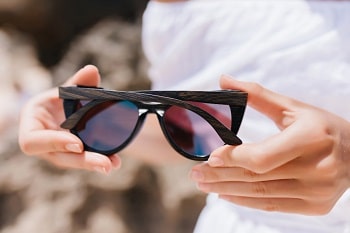
Polarized Lenses
Light reflects and bounces off of everything, so by the time the sunlight outside reaches your eyes, it’s coming from more than just the sun. The sun’s rays reflect off of surfaces such as cars, lakes, grass, trees, and just about everything else. This causes horizontal reflecting rays of light, which we see as glares.
Sunglasses with polarized lenses eliminate glare, meaning less squinting! Polarized lenses have an anti-glare property that is created by applying a chemical film that blocks out horizontal light rays while still allowing us to see vertical rays to reduce the glare we see.
Benefits of Polarization
The most obvious perk of polarized lenses is that they stop glare. But outside of dampening reflections, polarization is also great for:
- Enhanced color vibrancy
- Relief from eye strain
- Increased visual contrast
- Overall clearer vision
- Relief from squinting
- The prevention of wrinkles around the eyes
Polarized shades are especially ideal for outdoor activities like snowboarding, skiing, boating, fishing, biking, and watersports. Because glare is a known cause of car wrecks, they’re also an absolute safety staple for anyone who drives.
What is UV Protection?
Most people already have the basic concept down pat: ultraviolet rays = bad and dangerous. That’s one of the main reasons why we put on sunscreen and wear protective eyewear in the first place.
To put it in more concrete terms, UV light is a particular wavelength of radiation that proves especially damaging to our skin and eyes. And its wavelength is higher than the visible spectrum of light. In other words, one of the most dangerous elements of UV rays is that we can’t see them at all, which sometimes means we’re unaware they’re there until the damage is already done.
UV rays are present year-round—even on extremely cloudy days. And wherever there’s UV rays, there’s the danger of severe eye damage. Excess UVA and UVB exposure won’t just leave your eyes burning and irritated; it can also impair your cornea, damage your retina and cause macular degeneration, cataracts, and abnormal growths. Not to terrify you, but in the most severe cases you could even go completely blind.
With that in mind, “UV protection” refers to a pair of sunglasses’ ability to effectively block ultraviolet rays. This is done through UV filters which manufacturers apply to lenses either as a treatment or a coating. Alternatively, in the case of polycarbonate lenses UV protection comes built in. Either way, the goal of these ultraviolet filters is to absorb harmful rays, stopping them in their tracks before they even have the chance to damage your eyes.
Quality UV-blocking sunglasses like the shades offered by WMP Eyewear are able to block almost all of the ultraviolet rays they encounter—around 99 - 100 percent. When shopping for sunglasses, never settle for anything less than a rating of UV 400 or higher.
Benefits of UV Protection
Not losing your vision or damaging your eyes is the most obvious perk of UV protection. But at the end of the day, ultraviolet protection should be considered less of a cool perk and more of an absolute standard.
In other words, make UV protection 100% mandatory. Outside of adding a stylish twist to your ensemble, the whole point of sunglasses is to protect your eyes from harmful rays. So when it comes to UV protection, never cut corners or compromise.
If you’re shopping for sunglasses of any kind, be sure the label or product description clearly lists 400 UVA or UVB protection. If you’re uncertain whether the pair you’re considering meets international UV-blocking standards, it’s simply not the pair for you.
Polarization Vs. UV Protection
Want the bottom line? Polarization and UV protection have absolutely nothing to do with each other.
Polarization means that a pair of sunglasses is able to filter out horizontal light waves, dampening unwanted glares and reflections. It also means increased color vibrancy, more dramatic contrast, and enhanced vision clarity.
UV protection, on the other hand, refers to a pair’s ability to absorb harmful UV rays, meaning it’s able protect your eyes from the long-term damage caused by overexposure.
The key takeaway? Not all UV-blocking shades are polarized. And just because a pair of sunglasses is advertised as “polarized” doesn’t necessarily guarantee that it’s up to snuff on UV-protection—so always check that label for the 100% UVA/UVB indicator.
At the end of the day, polarization is a matter of personal preference, but there’s really no wiggle room when it comes to UV-protection.
You need UV protection. It’s possible you want polarization, too. The good news is that you don’t have to pick and choose. Plenty of Golden Eye Optometry Eyewear’s collection offer full UV 400 protection with polarized filters—so you can have your cake and eat it, too.
Sources:
- UV vs. Polarized Lenses: What’s the Difference? July 27, 2022
- UV PROTECTION VS POLARIZATION: WHAT'S THE DIFFERENCE? June 01, 2020
Make your appointment today
To make your appointment, simply give us a call (760)-948-3345 or
or
Due to COVID-19 safety protocols, all eyewear services are currently by appointment only. Please call to make an appointment.
At Golden Eye Optometry, we view good vision care as front line protection at every age. A routine eye exam can detect more than poor vision. It can shed early light on glaucoma, macular degeneration, cataracts and diabetes.